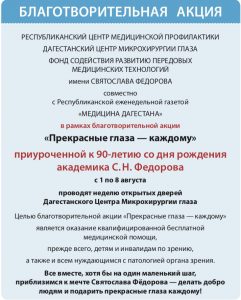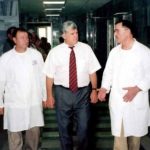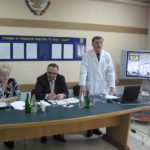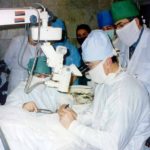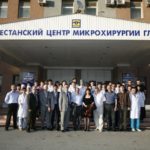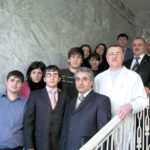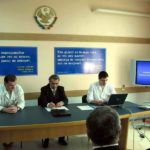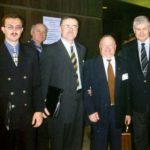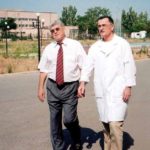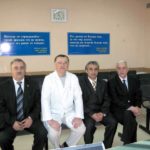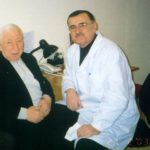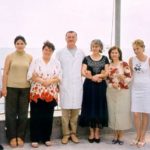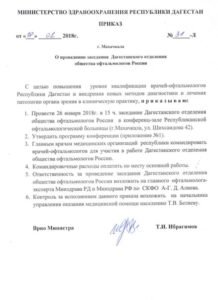Ads
-
Announcement to inform applicants for 2022-2023 academic year!
The reception of documents for specialist degree ends on September 23, 2022! The date of the chemistry and biology exams is 26th to 27th of October, 2022.Classes start on November 1,2022. It’s necessary to inform about arrival to DSMU before 10 days. The...
17.10.2022
358
-
Телефон для приема сообщений о коррупционных проявлениях:
68-32-80
-
Эл. почтовый ящик:
Ubdgmu@mail.ru
Eye Diseases Department №1 of Continuing Medical Education
17.05.2021
217
Head of the Department: Aliev Abdulgamid Davudovich
History of the department’s development
The Department of Ophthalmology was founded in 1935 by Professor H. O. Bulach, who was one of the co-organizers of the Dagestan Medical Institute establishment in 1932. H. O. Bulach headed the department and the clinic of eye diseases until his death.
Professor Haji Omarovich Bulach (1894-1959) was a prominent scientist, public health official, and statesman of Dagestan. He was elected deputy of the Supreme Soviet of Dagestan, Deputy Chairman of the Presidium of the Supreme Soviet of the Republic. While still a student at the University of Odessa, H. O. Bulach was deeply impressed by the lectures and practical activities of the ophthalmologist academician V. P. Filatov. This aroused H. O. Bulach’s great interest in this field of medicine.
In 1931, H. O. Bulach brilliantly defended his doctoral dissertation on the topic: “On the morphology of the optic nerve and retina in the light of the research of the Spanish school”. After completing his dissertation, H. O. Bulach receives an invitation from the leadership of Dagestan and the organizing committee to participate in the organization and establishment of a medical institute in the republic. He gladly accepts this invitation and immediately becomes a member of the organizational bureau, and then Deputy Director for administrative work. In 1933, H. O. Bulach organizes and heads the Department of Histology, and in 1935, as noted above, creates a department and directs the clinic of ophthalmology of the Dagestan Medical Institute.
In the post-war years, the public health service of Dagestan was tasked with eliminating trachoma as a mass disease. And Professor H. O. Bulach successfully coped with this task, relying on numerous colleagues and students.
Professor H. O. Bulach is the organizer and the first chairman of the Board of the Dagestan Society of Ophthalmologists, which continues its activities fruitfully at the present time. In tribute to his memory, in 1993 the Dagestan Society of Ophthalmologists was named after Professor H. O. Bulach.
Since July 1959, the Department of Eye Diseases was headed by Candidate of Medical Sciences, Associate Professor Aishat Isaevna Magomedova (1923-2004), who will forever remain in the memory of grateful students and colleagues as a professional in her field, as a person of high culture.
Since September 1971, the head of the department was elected Doctor of Medical Sciences, Nikolai Markovich Sergienko, who defended his doctoral dissertation “Research on the theory of clinical refraction of the human eye” in 1970 at the Odessa Research Institute of Eye Diseases named after Academician V. P. Filatov. N. M. Sergienko is the author of 5 monographs, more than 400 scientific papers on fundamental problems of clinical refraction and eye microsurgery, has more than 20 patents on various methods of diagnosis and treatment of eye diseases. Currently, N. M. Sergienko is the Director of the Ukrainian Center for Eye Microsurgery, Head of the Department of Ophthalmology of the Institute of Advanced Medical Training, Academician of the Academy of Sciences and the Academy of Medical Sciences of Ukraine. Nikolai Markovich maintains close scientific and purely human contacts with his Dagestani colleagues, is interested in the development of the ophthalmological service, socio-economic and cultural transformations in our Republic of Dagestan. From September 1976 to December 1988, the Department of Ophthalmology was headed by Associate Professor Shamkhal Dibir-Alievich Shamkhalov (1924-2001). In 1959, at the Moscow Helmholtz Research Institute of Eye Diseases, he defended his PhD thesis on the topic: “Methods of bone hole formation in dacryocystorinostomy”. He is the author of the monograph “Dacryocystitis”. Proposed by Sh. D-A. Shamkhalov tool for the formation of a bone hole in dacryocystorinostomy is used in many eye clinics in Russia.
Sh. D.-A. Shamkhalov was a man of versatile talent: an excellent ophthalmologist, a talented musician-composer, a mentor of young people, he was always in the thick of the scientific and cultural life of the institute: he led the amateur art activities of the Dagestan Medical Academy, organized and until the last days of his life led the vocal and instrumental ensemble of the DSMU “Khrustallik”. In 1998, for his contribution to the development of the culture of our Republic, Sh. D. A. Shamkhalov was awarded a high title of the State Prize winner of the RD.
Since December 1988, Professor Abdul-Hamid Davudovich Aliyev has been the head of the Department of Ophthalmology. Candidate’s thesis “Research of conditions of rational correction of astigmatism” A-G. D. Aliyev defended in 1980 at the Odessa Research Institute of Eye Diseases named after Academician V. P. Filatov. In 1993, at the Helmholtz Moscow Research Institute of Eye Diseases, A.-G. D. Aliyev defended his doctoral dissertation “Aberrations of the optical system of the human eye in normal and pathological conditions and their role in the process of visual activity”. In the same year, he was confirmed in the rank of professor.
A-G. D. Aliyev is the author of more than 500 scientific papers, many of which have been published in the foreign press, 35 copyright certificates and patents of the Russian Federation for inventions, 10 patents of the Russian Federation for utility models, more than 50 diagnostic and treatment methods implemented in the clinical practice of ophthalmological medical institutions in Dagestan, Russia and the CIS. Together with the staff of the department, he has developed more than 30 teaching aids for students and ophthalmologists who are studying and improving their skills in the system of postgraduate education.
The main areas of scientific research of Professor A-G. D. Aliyev are clinical aberrology of the eye optical system, the study of the eye optical system quality influence on visual functions in various optical-reconstructive interventions and pathological conditions.
Professor A-G. D. Aliyev is the author of 3 monographs: “Aberrations of the optical system of the eye during artificial lens implantation”, published in 2000 in Moscow (jointly with M. I. Ismailov), “Thermoelectric semiconductor converters in medicine”, published in 2000 in Makhachkala (jointly with prof. T. A. Ismailov, prof.A. I. Khamidov) and “A short guide to dacryology”, published in 2006 in Makhachkala (jointly with associate professor Sh. Under the guidance of Professor A-G. D. Aliyev, 6 PhD theses were completed and defended, 1 doctoral and 4 PhD theses are being prepared for defense.
In 1994, Professor A-G. D. Aliyev was elected Chairman of the Board of the Dagestan Society of Ophthalmologists, and at the VII Congress of Ophthalmologists of Russia – a member of the Board of the All-Russian Society of Ophthalmologists.
Professor A-G. D. Aliyev is a member of the editorial boards and editorial boards of All-Russian ophthalmological publications-journals “Ophthalmosurgery”, “Russian Ophthalmological Journal”, “New in Ophthalmology”, “Glaucoma”, “Ophthalmology”, “Refractive Surgery and Ophthalmology”, etc. In 1997, a collection of scientific papers “Actual problems of Ophthalmology” was published under the editorship of A. G. D. Aliyev, dedicated to the 100th anniversary of the birth of Professor H. O. Bulach and the 65th anniversary of the Dagestan Medical Institute founding. In 2002 and in 2007, under the general editorship of A-G. D. Collections of scientific papers “New technologies of diagnostics and treatment in ophthalmology” have been prepared for publication, which include scientific works not only by the staff of the Department and the clinic of Ophthalmology of the DSMU, but also by many ophthalmological clinics in Russia and the CIS. These collections of scientific papers are dedicated to the 70th and 75th anniversary of the Dagestan Medical Academy founding.
On the initiative of Professor A-G. D. Aliyev, the All-Russian Conference of Ophthalmologists was held in Makhachkala in 2008. A new collection of scientific papers “The state and ways of improving the quality of ophthalmic care in the regions of Russia” has been published.
Under the guidance and direct participation of Professor A-G. D. Modern methods of prevention, diagnosis and surgical treatment of eye diseases have been introduced into the clinical practice of the Republican Ophthalmological Hospital: artificial lens implantation, sclerotic strengthening operations for progressive myopia, microsurgical treatment of glaucoma using allogeneic drains, refractive surgery, complex combined surgical interventions for combined eye pathology, intraoperative ultrasound diagnostics, vitrectomy and vitreolensectomy, new methods of surgical treatment in the pathology of the lacrimal tract and others. The search, development and implementation of new technologies for diagnosis and treatment are in a state of continuous development.
Since 1990, a course of postgraduate education and advanced training of doctors has been opened on the basis of the department. This made it possible to create a system for the training of qualified medical personnel, to improve the quality of postgraduate professional education of ophthalmologists of the republic.
In 2002, Professor A-G.D. Aliyev was appointed director of the research and production association “Dagestan Center for Eye Microsurgery.”
In different years, talented scientists and health care organizers worked at the department, who made their worthy contribution to the development and improvement of the ophthalmic service of the Republic.
Assistant Maria Nikitichna Bulach (1918-1984) defended her thesis on the problems of preventing and treating eye injuries in Dagestan. Everyone who knew and worked with Maria Nikitichnaya was remembered as an energetic and highly erudite specialist and simply as a responsive person and charming woman.
Associate Professor Nariman Hajimagomedovich Madiev (1926-2008) completed his thesis on the problem of early diagnosis and treatment of glaucoma. N.G. Madiev successfully combined ophthalmological work with research and pedagogical work in the field of health care and social hygiene.
Associate Professor Nabi Nurmagomedovich Huseynov (1925-1996) devoted his scientific activity to the problem of studying the complications of the visual organ in brucellous infection, successfully defending a candidate dissertation on the topic “Brucellosis and the Eye” under the guidance of Professor H.O. Bulach in 1953 at the Stalingrad Medical Institute. For many years, Medical Service Colonel Associate Professor N.N. Huseynov devoted himself to military medical service, working with dignity and honor in various regions of our country and beyond. Working in senior positions of the military medical service, he proved himself an experienced organizer and a highly qualified specialist. For services to the fatherland N.N. Huseynov was awarded many orders and medals. The fundamental, responsible, punctual, strict and sensitive remains in the memory of colleagues, friends and patients Nabi Nurmagomedovich Huseynov.
In the prime of creative forces, the life of Associate Professor Elbert Khadzhievich Bulach (1941-2000) was cut short. E.K. Bulach’s candidate dissertation is devoted to the study of the histochemical and biomechanical properties of the scleral capsule of the eye with progressive myopia (1971). Associate Professor E.H. Bulach made a great contribution to the creation of the faculty for working with foreign students of the DSMA, first as dean, and then vice-rector of the DSMA. Balanced, friendly, intelligent, always ready to come to the aid of the sick and needy – this is how E.H. Bulach was remembered by everyone.
Professor Zaire Abdul-Malikovna Makhacheva worked at the department from 1985 to 2007. At FSI Interbranch scientific and technical complex “Microsurgery of the Eye” named after S.N. Fedorova, Moscow (1994) defended his doctoral dissertation “Anatomical and functional substantiation of surgical interventions on the vitreous body in vitreal destruction.”
Assistant Erika Ilyasovna Dolgatova worked at the department from 1983 to 2009. At the Moscow Research Institute of Eye Diseases named after Helmholtz defended (1992) her thesis on the topic: “Diagnosis and clinical and morphological picture of brucellosis of the eye.” He is engaged in the study of the problem of etiological immunodiagnostics and immunotherapy of inflammatory diseases of the eye.
Associate Professor Grigory Naumovich Gitelman has been working at the department since 1968. At the Moscow Research Institute of Eye Diseases named after Helmholtz in 1969 he defended his thesis on the topic: “Comparative assessment of methods for diagnosing lesions of the oculomotor apparatus and the use of the principles of cybernetics for this purpose.” He is the author of more than 50 scientific papers, 1 patent of the Russian Federation for invention, 9 rationalization proposals, 12 teaching aids for students and practical doctors. Associate Professor G.N. Gitelman is a consultant and curator of the Republican Office for the Protection of Children’s Vision, advises and transfers his experience in treating the pathology of the oculomotor apparatus to young colleagues.
Associate Professor Zaira Nabievna Maksudova has been working at the department since 1981. At the Moscow Research Institute of Eye Diseases named after Helmholtz defended (1994) her thesis on the topic: “Some features of dynamic refraction of the eye during laser refractometry and its use to clarify optical correction.” He is the author of more than 30 scientific papers, methodological recommendations on the use of a laser refraction analyzer LAR-2 (together with Professor Yu.Z. Rosenblum). Since 2006, she has been appointed deputy director of the State University of SPA “Dagestan Center for Eye Microsurgery” for organizational, methodological and clinical expert work.
Associate Professor Elmira Shamkhalovna Shamkhalova has been an employee of the department since 1989. At the Moscow Research Institute of Eye Diseases named after Helmholtz (1989) defended her thesis on the topic: “Long-term results of sclera-strengthening operations in progressive myopia and prediction of the effect of operations.” He is the author of 47 scientific papers, 3 copyright certificates and patents for inventions of the Russian Federation, more than 20 rationalization proposals, 11 teaching aids and recommendations. He is studying the problem of progressive myopia. As executive secretary of the Dagestan Society of Ophthalmologists, he conducts a lot of work to improve the work of the public organization of Dagestan ophthalmologists.
Associate Professor Zaire Nutsalkhanovna Akhmedova has been working at the department since 1993. At the Academy of Postgraduate Education in Moscow, she defended (1993) her thesis on the topic: “Organ of vision in the surgical correction of severe forms of diabetes mellitus.” He is the author of more than 40 scientific papers, 5 rationalization proposals.
Professor Muslim Ismailovich Ismailov has been working at the department since 1999. At FSI Interbranch scientific and technical complex “Microsurgery of the Eye” named after actor S.N. Fedorova, Moscow (2003) defended his doctoral dissertation on the topic: “Study of the role of aberrations of the optical eye system in ophthalmosurgery.” He is the author of more than 150 scientific papers, 11 patents of the Russian Federation for inventions and 9 certificates of the Russian Federation for useful models, 1 monograph, 15 teaching aids and recommendations. For active participation in the research and inventive work of the DSMA M.I. Ismailov in 2002, by decree of the State Council of the RD, he was awarded the honorary title “Honored Inventor of the Republic of Dagestan.” With the opening at the department of advanced training of doctors by order of the rector of the DSMA in 2007, he performs the duties of head of the course for postgraduate education and advanced training of doctors.
Assistant Zariyat Dzhalaludinovna Hajieva has been working at the department since 2000. At the Moscow Academy of Postgraduate Education, she defended (2000) her thesis on the topic: “Comparative assessment of various methods of nonspecific immunotherapy in the treatment of adenovirus keratoconjunctivitis and their improvement. He is the author of more than 15 scientific papers, methodological recommendations and rationalization proposals.
Assistant Magomed Aripovich Magomedov has been working at the department since 2001. At FSI Interbranch scientific and technical complex “Microsurgery of the Eye” named after SN Fedorova, Moscow, defended his thesis (2001) on the topic: “Causes of low visual functions in patients with operated retinal detachment with anatomical adjoining and methods of their correction.” The author of more than 20 scientific papers, teaching aids and recommendations. Since 2009, he has been working as a methodologist in the control and methodological department of the DSMA.
Assistant Sharipov Genet Nabibulaevna has been working at the department since 2007. At FSI Interbranch scientific and technical complex “Microsurgery of the Eye” named after S.N.Fedorova, Moscow (2006), defended her thesis on “Prevention of proliferative vitreoretinopathy using 5-fluorouracil on hydrogel carrier (experimental morphological examination).” He is the author of more than 18 scientific papers, 1 patent of the Russian Federation for the invention. Since 2007 Head of the Department of Vitreoretinal Surgery at the State University of SPA “DCEM”.
Assistant Aliyev Ahmed Abdul-Hamidovich has been working at the department since 2009. At the State Research Institute of Eye Diseases, RAMS defended his thesis (2008) on the topic: “Features of optical corneal aberrations in pterygium surgery.” He is the author of more than 100 scientific papers, 14 patents of the Russian Federation for inventions and utility models, 6 teaching aids and recommendations. Introduced high-tech methods for the diagnosis and treatment of eye diseases into the clinical practice of the DCEM SPA, such as excimerlaser vision correction, energy seamless cataract surgery with in-jector implantation of flexible IOL, IAG – laser reconstructive surgery of the anterior segment of the eye and secondary cataract, computer keratotopometry in A. A-G. Aliyev is the scientific director of the Council of Young Scientists and Researchers of the Department and the State University of SPA “DCEM”.
Assistant Aliyev Ahmed Abdul-Hamidovich has been working at the department since 2009. At the State Research Institute of Eye Diseases, RAMS defended his thesis (2008) on the topic: “Features of optical corneal aberrations in pterygium surgery.” He is the author of more than 100 scientific papers, 14 patents of the Russian Federation for inventions and utility models, 6 teaching aids and recommendations. Introduced high-tech methods for the diagnosis and treatment of eye diseases into the clinical practice of the DCEM SPA, such as excimerlaser vision correction, energy seamless cataract surgery with in-jector implantation of flexible IOL, IAG – laser reconstructive surgery of the anterior segment of the eye and secondary cataract, computer keratotopometry in A. A-G. Aliyev is the scientific director of the Council of Young Scientists and Researchers of the Department and the State University of DCEM SPA.
In 2005, together with Professor M.I. Ismailov, he received an international grant from Bausch & Lomb for research work on the problem of dry eye syndrome.
In 2008, at the “VIII Moscow International Salon of Innovations and Investments” for the development of a new method of surgical treatment of the pathology of the anterior segment of the eye, using laser technologies, he was awarded a silver medal.
Since 2009 works as deputy director for scientific and clinical work at DCEM SPA.
Senior laboratory assistants Aminat Magomedovna Huseynova and Sarizhat Alilovna Alishaeva take part in the organization of the educational process of the Department of Eye Diseases.
Currently, employees of the Department of Ophthalmology together with employees of three clinical bases: the State University of the SPA Dagestan Center for Eye Microsurgery, the Republican Ophthalmological Hospital and the High Technologies Eye Clinic are working to improve the organizational foundations of ophthalmological assistance to the population of the Republic of Dagestan, optimize the system of postgraduate education and improve the professional qualifications of practical doctors, introduce new technologies for the diagnosis and treatment of eye diseases in clinical practice.
Next to those who today continue with their daily work the best traditions of the DSMA ophthalmology clinic, young forces reach new peaks with their senior colleagues and mentors, whose names will undoubtedly appear on the new pages of the history of the development of Dagestan ophthalmology.
History of the development of the ophthalmic service of the Republic of Dagestan
The history of the development of the ophthalmic service of the republic is continuously connected and begins in 1935 – from the founding of the department and clinic of eye diseases of the Dagestan Medical Institute. Prior to this, there were no specialized doctors for eye diseases in Dagestan. Ophthalmological assistance to the population of our republic was provided by “flying” teams of ophthalmologists from other ophthalmological clinics in Russia: Stavropol, Krasnodar, Rostov-on-Don, etc.
He founded the Department of Eye Diseases of Dagmedinstitut our fellow countryman, a famous scientist, professor H.O. Bulach, who headed it until the end of his life (1959). Non-youth organizational talent, selfless humanism, scientific mind, excellent pedagogical skill and brilliant organizational abilities, the golden hands of the surgeon and the analytical thinking of the researcher were firmly intertwined and harmoniously combined in this person.
Since the founding of the department, the first clinic of eye diseases with 30 beds has been opened on the basis of the Republican Clinical Hospital. At that time, only 3 doctors worked in this clinic, who provided ophthalmological assistance to the population of the whole Republic.
During the Great Patriotic War, H.O. Bulach, in addition to the eye clinic, was in charge of the eye department of the evacuation hospital in Makhachkala. Hundreds of injured with eye injuries received help from his good hands, bringing relief and doing a miracle.
After World War II in the republic on the basis of the eye department of the RCB in 1954 a trachomatous dispensary with 15 beds was opened, in which 2 doctors worked. His first chief physician was M.N. Bulach. Professor H.O. Bulach led the work on the elimination of trachoma in Dagestan until the end of his life. Under his leadership and direct participation, “eye” detachments were organized, which examined the entire population. Thanks to the persistent and painstaking activities of these detachments and the trachomatous dispensary, which has been conducted for many years, not a single fresh case of trachoma since the 60s has been recorded in Dagestan.
After the death of Professor H.O. Bulach, the Department of Ophthalmology was headed by Associate Professor A.I. Magomedova, who, together with H.O. Bulach, took an active part in the fight against trachoma in Dagestan.
Since 1971 Head of the Department of Ophthalmology and Head of the Eye Clinic of the RCH was elected by competition to the young Doctor of Medical Sciences N.M. Sergienko from the Donetsk Eye Clinic.
Under the leadership of Professor N.M. Sergienko, microsurgical technologies for the treatment of eye diseases were introduced in the eye clinic, a vivarium laboratory was organized and an experimental base was created for the preclinical testing of new technologies for the diagnosis and treatment of eye diseases and the training of doctors in the postgraduate education system.
From September 1976 to 1988 the department of ophthalmology was headed by Associate Professor S.A. Shamkhalov. Together with Professor V.A. Beloglazov, he wrote a monograph on the surgical treatment of the pathology of the lacrimal tract. The cutter calipers proposed by S.A. Shamkhalov for the formation of a bone hole during dacryocystorinostomy is used in many eye clinics in Russia.
From 1988 to the present, the Department of Ophthalmology is headed by Doctor of Medical Sciences, Professor A-G.D. Aliyev, who is Chairman of the Board of the Dagestan Society of Ophthalmologists named after prof. H.O. Bulach.
The second eye department with 30 beds was opened in Makhachkala in 1963, on the basis of the 2nd city hospital. 3 eye rooms in 3 clinics were also opened.
In 1976 the eye compartment of the RCH was brought from 30 to 60 beds, and after another 3 years to 75 beds. The republican trachomatous dispensary grew to 75 beds, which in 1978 was given the status of a glaucoma dispensary, headed by a doctor of the highest category, Honored Doctor of the RD, holder of the Order of Friendship of Peoples T.Ya. Kolotova. A clear system of diagnosis, treatment, prevention and medical examination of glaucoma in the republic was created. There were regular posts of oculist doctors in the cities and districts of the republic.
In 1978 A children’s eye unit with 30 beds was opened on the basis of the RCH, which was transferred to the Children’s Multidisciplinary Hospital in 1982. In the same year, the Republican Laboratory for Contact Correction of Vision was opened.
December 15, 1984 by order of the Minister of Health of the Republic, on the basis of the republican trachomatous dispensary, a Republican ophthalmic hospital with 150 beds, the only one in the North Caucasus, was created from 3 disparate departments. Her first chief physician was appointed a doctor of the highest category, an excellent student of healthcare of the RD A.A. Efendiev.
With the opening of the ophthalmic hospital, the ophthalmic service of the Republic rose to a higher quality level.
The clinical practice of the Republican Ophthalmic Hospital includes modern methods of preventing, diagnosing and surgical treatment of eye diseases: implantation of an artificial lens, various types of sclera-strengthening operations in progressive myopia, microsurgical treatment of glaucoma using allogeneic drains, refractive surgery, complex combined surgical interventions in combined eye pathology, vitreolensectomy, new surgical treatments for lacrimal passages pathology.
To date, there are 4 specialized departments in the Republican Ophthalmic Hospital: retinal pathology, glaucoma, pediatric, eye injuries and an advisory and diagnostic clinic, as well as the republican office for the protection of children’s vision. On the basis of the hospital there is the Department of Eye Diseases of the DSMA, a contact vision correction room, a specialized eye MSEC, an urgent and emergency care service for patients with emergency vision pathology. In addition to budget departments, the OCULUS self-accounting medical and diagnostic department operates on the basis of the hospital.
Currently, since 1996, the Republican Ophthalmic Hospital has been headed by Dr. L. G. Gafurova, who heads a team of 43 ophthalmologists, 20 of whom are specialists of the highest category. The hospital has 4 candidates of medical sciences, 1 doctor of medical sciences, 5 doctors with the honorary title “Honored Doctor of the RD,” 11 doctors have the title “Excellence in Healthcare of the RD, 2 doctors -” Excellence in Healthcare of the Russian Federation.” Over the 25 years of the existence of the Republican Ophthalmic Hospital, more than 170 thousand people were treated in it, of which about 90 thousand patients were operated on.
Along with the great medical and diagnostic work, the Republican Ophthalmic Hospital carried out huge organizational and methodological work in the Republic. Over 25 years, ROH doctors made more than 1500 trips to cities and regions of the Republic. More than 7000 days were spent there and about 65 thousand people were examined. Together with the Department of Eye Diseases of the DMA, the ROH is constantly engaged in improving the qualifications of ophthalmologists of the Republic. On the basis of the ROB during this time, more than 200 ophthalmologists underwent advanced training and certification.
In February 1993 Decree of the Council of Ministers of the Republic of Dagestan No. 32 of 22.02.1993 The Republican Ophthalmic Hospital is named after Professor H.O. Bulach.
On July 18, 2002, in accordance with Decree of the Government of the Republic of Dagestan No. 130, a new ophthalmological institution of the Republic was formed, the scientific and production association “Dagestan Center for Eye Microsurgery.”
The beginning of the operation of the Center for Eye Microsurgery is October 8, 2002, when an order was issued by the Minister of Health of the Republic of Dagestan I.A. Mamaev No. 489-P “On the opening of the State Institution” Scientific and Production Association “Dagestan Center for Eye Microsurgery” Ministry of Health RD. ” Professor A-G.D. was appointed Director of DCEM SPA. Aliyev, – Head of the Department of Eye Diseases with a course of improvement of DSMA doctors.
Under the guidance of Professor A-G.D. Aliyev introduced more than 50 new technologies for diagnosing and treating diseases of the visual organ in eye clinics of the republic.
In 2008, the All-Russian Conference of Ophthalmologists was held in Makhachkala. A new collection of scientific works “State and Ways to Improve the Quality of Ophthalmic Care in the Regions of Russia” has been published.
The clinical practice of the Dagestan Center for Eye Microsurgery introduced modern high-tech methods for the prevention, diagnosis and surgical treatment of diseases of the visual organ: microinvasive cataract energy surgery with implantation of elastic intraocular lenses, transpupillary laser and endovitreal surgery in diabetic retinopathy, vitreoretinal surgery for combined eye pathology, surgical and laser treatment for retinal detachment and rupture, optic-reconstructive interventions in scarring, haze and other corneal diseases, metabolic operations, sclera-strengthening operations in progressive myopia, complex treatment of glaucoma using microinvasive and laser surgery, laser selective trabeculoplasty, microinvasive surgical treatments for glaucoma using allogeneic drains, Ahmed valve implantation in refractory glaucoma, excimerlaser refractive surgery, complex combined surgery in combined eye pathology, intraoperative ultrasound diagnosis, new surgical treatments for lacrimal tract pathology and others. The search, development and implementation of new diagnostic and treatment technologies are in a state of continuous development.
The scientific and production association is a new form of organization of not only medical, but also educational and pedagogical process in the system of postgraduate education and advanced training of ophthalmologists. By a joint order of the Minister of Health of the RD and the Rector of the DSMA No. 437-M/296-K, the Republican Educational and Scientific Methodological Center for Advanced Training and Postgraduate Education of Ophthalmologists was formed on the basis of the State Department of SPA DCEM.
DCEM SPA is equipped with the most modern equipment: the 7th generation Allegretto Wave excimer laser manufactured by the famous companies Coherent (USA) and WaveLight AG (Germany), designed for precision refractive operations, and the Wave Analyzer computer summary aberrometer, which allows assessing the quality of the human eye optical system, is the only officially registered instrument there are diagnostic computer devices that allow quickly and accurately determining the necessary parameters, operating microscopes, laser devices and tools that allow performing microsurgical operations at a new level, anaesthetic-resuscitation equipment that allows you to be calm for the patient’s condition.
With the opening of the Dagestan Center for Eye Microsurgery, the distance between scientific research and their practical application was sharply reduced. Today, DCEM develops, patents and introduces into practice the most advanced technologies for the diagnosis and treatment of eye diseases. In order to maximize the approach of specialized ophthalmic medical and diagnostic care to the population, by order of the Ministry of Health of the RD, visiting diagnostic teams of ophthalmologists were organized, traveling on mobile diagnostic modules equipped with modern equipment based on the Gazelle car. These brigades make systematic trips to cities and regions of the republic. Thanks to such an organization of work, thousands of Dagestanis received a qualified examination, hundreds of patients were sent for surgical treatment to specialized clinics in Makhachkala.
In the work of DCEM, the structural sequence of admission, examination and treatment of patients is clearly defined. Each applicant passes through the advisory and diagnostic department – the “diagnostic line,” and, if necessary, is sent to the hospital.
DCEM SPA is represented by 65 beds and the following divisions: advisory and diagnostic department, reception department, laser refractive surgery department, vitreoretinal surgery department, glaucoma microsurgery department, retinal pathology and laser surgery department, microsurgical department, department of new technologies and plastic surgery, department “Eye diabetes,” children’s department, surgery department In the years since its creation, the Dagestan Center for Eye Microsurgery has managed to provide real assistance to many tens of thousands of Dagestanis, residents of neighboring regions. The clinic conducts up to 5 thousand operations and more than 20 thousand outpatient examinations per year.
Thus, the launch of the largest modern high-tech center for eye microsurgery in the North Caucasus region opens a new era in the development of a specialized ophthalmic service and the introduction of new medical technologies in our republic.
Summing up the above, we can say that if in 1935. only 3 ophthalmologists worked in the republic and 30 eye beds functioned, today there is a legion of qualified specialists represented by 193 ophthalmologists (38 of them are children); the ophthalmology service is represented by 102 rooms, 230 beds in the ROH, 20 beds in Derbent, 65 beds in the Dagestan Center for Eye Microsurgery. There are also 4 offices for the protection of children’s vision, 1 specialized kindergarten, 1 specialized boarding school for the blind and visually impaired, and 1 contact correction office.
In conclusion, we can state with confidence that the ophthalmological service of the republic is in a state of dynamic progressive development and continuous improvement. Only the basic principles of the Dagestan ophthalmological community, laid down by its founder, Professor H.O. Bulach, are unchanged.
SI SPA “Dagestan Center for Eye Microsurgery”
The Dagestan Center for Eye Microsurgery began its work on October 8, 2002 – by order of the Minister of Health of the Republic of Dagestan No. 489-P “On the opening of the State Institution” Scientific and Production Association “Dagestan Center for Eye Microsurgery” of the Ministry of Health of the RD.
Over the past time, more than 130 thousand patients underwent a diagnostic examination, more than 25 thousand operations of a high category of complexity were performed based on unique advanced technologies. Every year, about 5 thousand people are examined and treated in our center, of which 1.5 thousand are children.
The latest diagnostic and treatment technologies used in the Dagestan Center for Eye Microsurgery:
- Excimerlaser surgery – refractive surgeons widely replicate the correction of myopia, farsightedness, astigmatism by the LASIK method on the ultra-modern operating installation Allergretto WaveLight (WaveLight, Germany);
- Energy seamless method of cataract removal on the universal ophthalmosurgical complex “ASSISTANT” (“OPTICON,” Italy), using the “Minimum Stress” technology. Phacoemulsifiers from Alcon (USA) and Dorc (Netherlands) are also used;
- Vitreoretinal surgery – using the technology of transconjunctival seamless vitrectomy 23G, which is one of the most innovative areas in vitreoretinal surgery. These techniques allow performing the full volume of vitreoretinal intervention in patients with different intraocular pathology through point punctures. By minimizing damage to eye tissues, avoiding the need for sutures, the risk of postoperative complications is significantly reduced, the patient returns to his usual lifestyle much earlier than after operations performed using standard and traditional technologies;
- Metabolic surgery of age-related retinal and optic nerve dystrophies is an extremely promising direction in the scientific and surgical activities of employees of the Bioplant biomaterial of the Dagestan Center for Eye Microsurgery. In recent years, Bioplant has been successfully used in the treatment of diabetic retinopathy, retinopathy of prematurity, retinitis pigmentosa, atrophy and neuritis of the optic nerve, uveitis, retinal vein thrombosis, linen, injuries, keratitis, myopia, burn tumors and birth defects;
- Microinvasive and laser glaucoma surgery is the most effective technique for glaucoma surgery, developed by Svyatoslav Fedorov, called “non-penetrating deep sclerectomy.” Its most important advantage is that it is carried out without opening the eyeball. High-class surgeons of the Dagestan Center for Eye Microsurgery perform surgery in modern operating rooms equipped with the latest microscopes, while only high-quality consumables and microsurgical tools are used. Laser glaucoma surgery reduces intraocular pressure and prevents blindness. It is safe for the patient, since operational and postoperative complications such as hemorrhage, damage to the lens, detachment of the retina and vascular membrane are practically excluded. For glaucoma surgery in the Dagestan Center for Microsurgery, the eyes use latest generation laser systems that have a very accurate focusing system on the problem zone. Laser treatment is painless and outpatient. It is particularly effective in the initial stages of glaucoma or during acute attacks;
- Laser surgery of diabetic retinopathy – this method of treating diabetic retinopathy has been used in DCEM for more than 5 years. According to statistics, correctly performed laser coagulation is effective in 85% of patients, and stabilization of the process can be achieved for many years. Specialists of the Dagestan Center for Eye Microsurgery are introduced into clinical practice and all modern laser surgery methods for diabetic retinal lesions are widely used.
Human resources capacity
On the basis of the State University of SPA “DCEM” there is a department of eye diseases with a course of improvement of doctors of DSMA. Together with the order of the Ministry of Health of the RD and the DSMA, the Republican Educational and Methodological Center for Advanced Training, Postgraduate Education, Certification and Certification of Ophthalmologists of the RD was formed. In 2005-2009, more than 180 doctors of the republic underwent advanced training and certification cycles on the basis of the DCEM in the system of postgraduate education.
The DCEM SPA employs 36 doctors. All doctors have a specialist certificate (100%). Of the 33 doctors subject to qualification, all are categorized.
Distribution of doctors by qualification category:
Highest category – 11 (32%)
Category I – 14 (43%)
Category II – 8 (25%)
From the indicated contingent of doctors:
4 doctors have the title “Honored Doctor of the RD”
Scientific degrees have 7 doctors, where:
1 – M.D., Professor
1 – C.m.s., Associate Professor
5 – C.m.s.
Photo gallery

